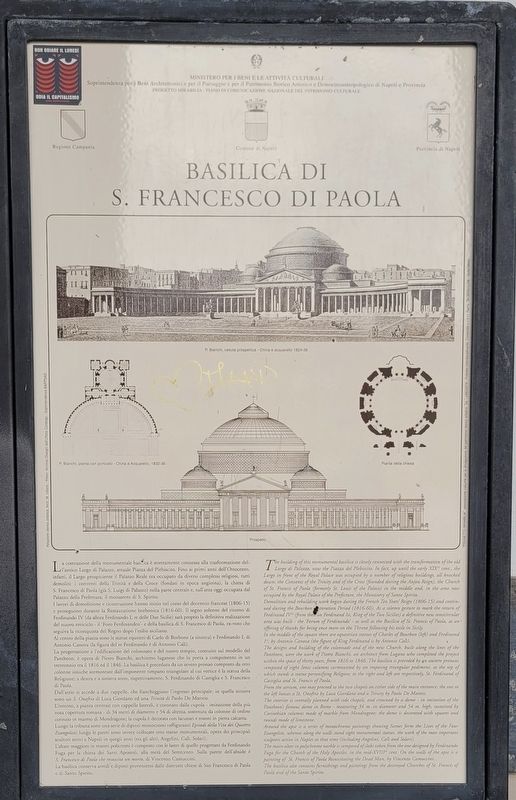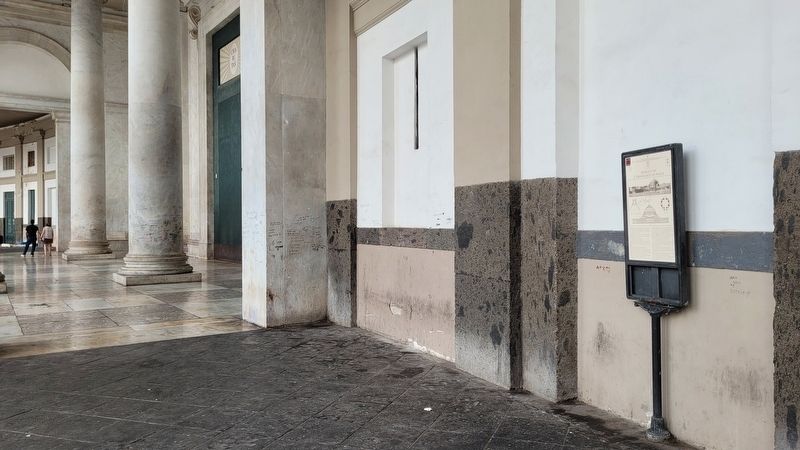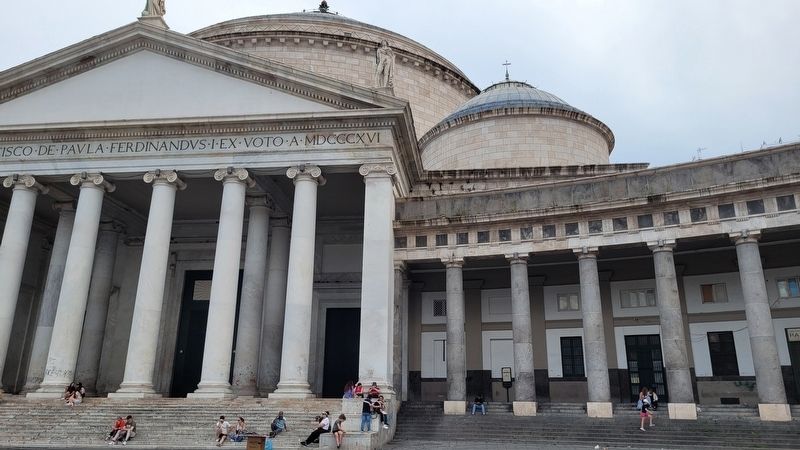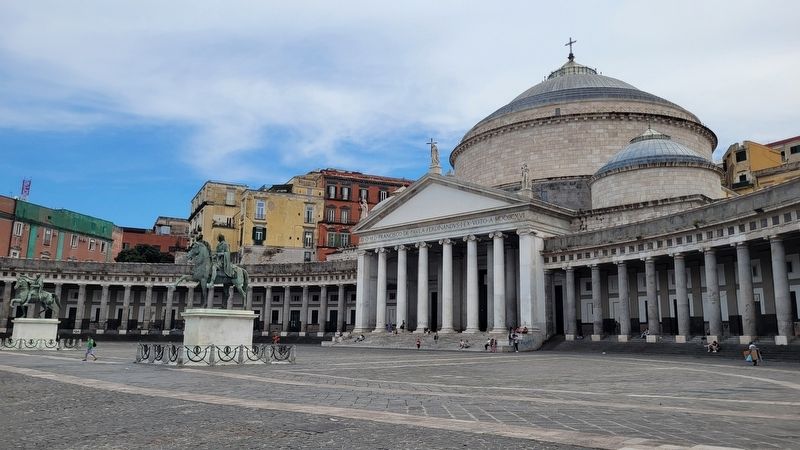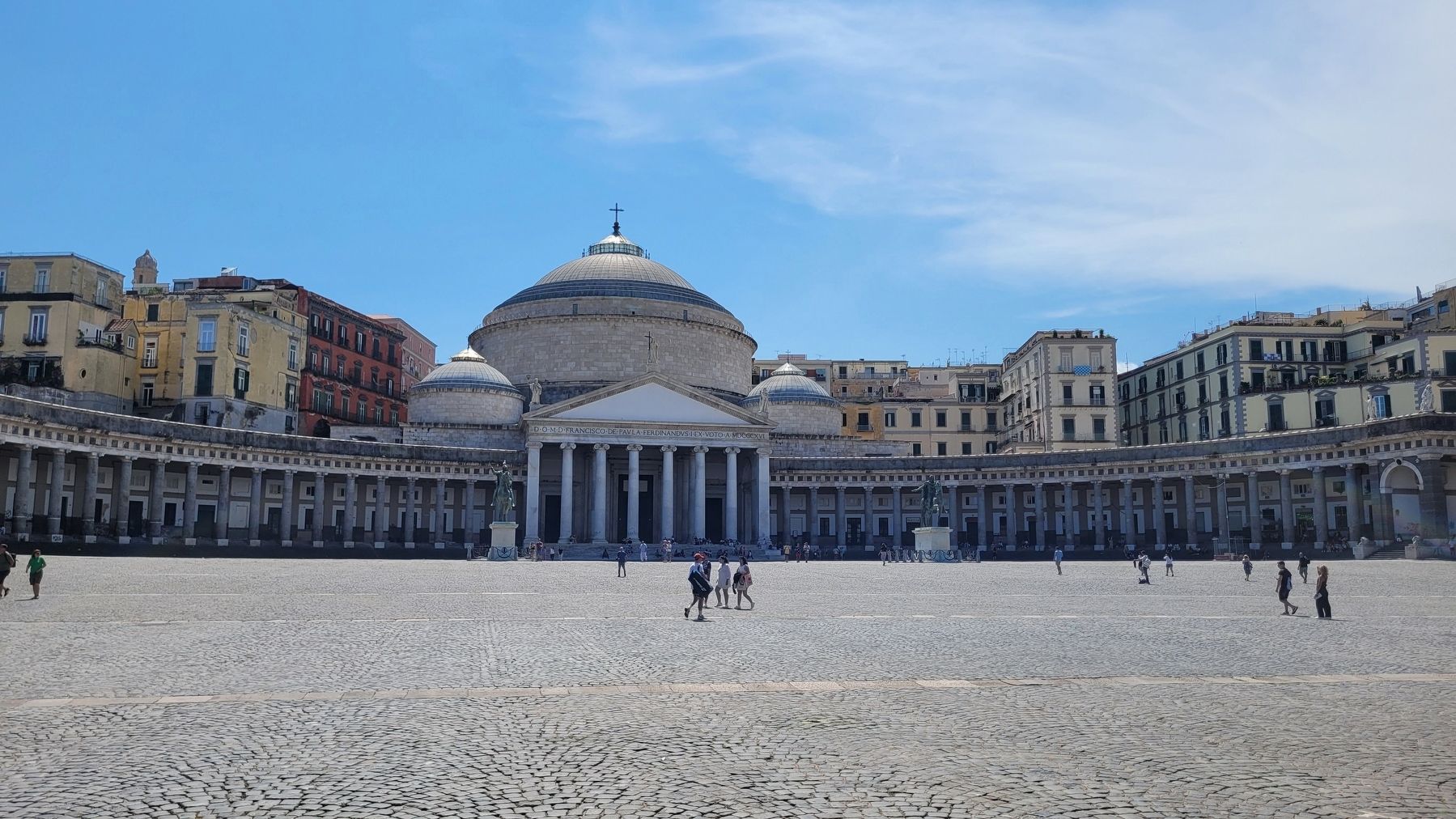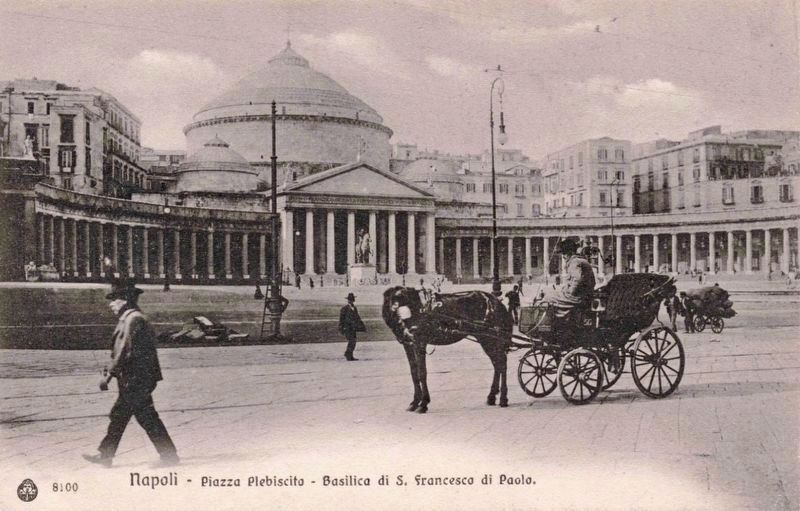San Ferdinando in Napoli in Città Metropolitana di Napoli, Campania, Italy — Southern Italy (Tyrrhenian Coast)
Basilica di S. Francesco di Paola / Basilica of St. Francis of Paola
Inscription.
I lavori di demolizione e ricostruzione hanno inizio nel corso del decennio francese (1806-15) e proseguono durante la Restaurazione borbonica (1816-60). Il segno solenne del ritorno di Ferdinando IV (da allora Ferdinando 1, re delle Due Sicilie) sarà proprio la definitiva realizzazione del nuovo emiciclo - il 'Foro Ferdinandeo'- e della basilica di S. Francesco di Paola, ex-voto che seguiva la riconquista del Regno dopo l'esilio siciliano.
Al centro della piazza sono le statue equestri di Carlo di Borbone (a sinistra) e Ferdinando I, di Antonio Canova (la figura del re Ferdinando è di Antonio Cali).
La progettazione e l'edificazione del colonnato e del nuovo tempio, costruito sul modello del Pantheon, è opera di Pietro Bianchi, architetto luganese che lo porta a compimento in un trentennio tra il 1816 ed il 1846. La basilica è preceduta da un severo pronao composto da otto colonne ioniche sormontate dall'imponente timpano triangolare al cui vertice è la statua della Religione; a destra e a sinistra sono, rispettivamente, S. Ferdinando di Castiglia e S. Francesco di Paola.
Dall'atrio si accede a due cappelle, che fiancheggiano l'ingresso principale: in quella sinistra sono un S. Onofria di Luca Giordano ed una Trinità di Paolo De Matteis.
L'interno, a pianta centrale con cappelle laterali, è coronato dalla cupola - imitazione della più nota copertura romana - di 34 metri di diametro e 54 di altezza, sostenuta da colonne di ordine corinzio in marmo di Mondragone; la cupola è decorata con lacunari e rosoni in pietra calcarea. Lungo la tribuna sono una serie di dipinti monocromi raffiguranti Episodi della Vita dei Quattro Evangelisti; lungo le pareti sono invece collocate otto statue monumentali, opera dei principali scultori attivi a Napoli in quegli anni (tra gli altri. Angelini, Cali, Solari).
L'altare maggiore in marmi policromi è composto con le lastre di quello progettato da Ferdinando Fuga per la chiesa dei Santi Apostoli,
alla metà del Settecento. Sulla parete dell'abside è S. Francesco di Paola che resucita un morto, di Vincenzo Camuccini.
La basilica conserva arredi e dipinti provenienti dalle distrutte chiese di San Francesco di Paola e di Santo Spirito.
Didascalie
P. Banchi, veduta prospettica - China e acquarello 1824-36
P. Bianchi, planta con porticato - China e Acquarelo, 1832-36
Pianta della chiesa
Prospetto
The building of this monumental basilica is closely connected with the transformation of the old Largo di Palazzo, now the Piazza del Plebiscito. In fact, up until the early XIX cent., the Largo in front of the Royal Palace was occupied by a number of religious building, all knocked down: the Convents of the Trinity and of the Cross (founded during the Anjou Reign), the Church of St. Francis of Paola (formerly St. Louis of the Palace) in the middle and, in the area now occupied by the Royal Palace of the Prefecture, the Monastery of Santo Spirito.
Demolition and rebuilding work began during the French Ten Years Reign (1806-15) and continued during the Bourbon Restoration Period (1816-60). As a solemn gesture to mark the return of Ferdinand IV (from then on Ferdinand Ist, King of the Two Sicilies) a definitive new semicircular area was built the Forum of Ferdinando
- as well as the Basilica of St. Francis of Paola, as an offering of thanks for being once more on the Throne following his exile in Sicily.
In the middle of the square there are equestrian statues of Charles of Bourbon (left) and Ferdinand 1, by Antonio Canova (the figure of King Ferdinand is by Antonio Cali).
The designs and building of the colonnade and of the new Church, built along the lines of the Pantheon, were the work of Pietro Bianchi, an architect from Lugano who completed the project within the space of thirty years, from 1816 to 1846. The basilica is preceded by an austere pronaus composed of eight lonic columns surmounted by an imposing triangular pediment, at the top of which stands a statue personifying Religion: to the right and left are respectively. St. Ferdinand of Castiglia and St. Francis of Paola.
From the atrium, one may proceed to the two chapels on either side of the main entrance: the one to the left houses a St. Onofrio by Luca Giordano and a Trinity by Paolo De Matteis.
The interior is centrally planned with side chapels, and crowned by a dome-in imitation of the Pantheon's famous dome in Rome measuring 34 m. in diameter and 54 m. high, sustained by Corinthian columns made of marble from Mondragone: the dome is decorated with squares and rounds made of limestone.
Around the apse is a series of
monochrome paintings showing Scenes form the Lives of the Four Evangelists, whereas along the walls stand eight monumental statues, the work of the most important sculptors active in Naples at that time (including Angelini, Call and Solari).
The main altar in polychrome narble is composed of labs taken from the one designed by Ferdinando Fuga for the Church of the Holy Apostles, in the mid-XVIII cent. On the walls of the apse is a painting of St. Francis of Paola Resuscitating the Dead Man, by Vincenzo Camuccini.
The basilica also contains furnishings and paintings from the destroyed Churches of St. Francis of Paola and of the Santo Spirito.
Captions
P. Banchi, perspective view - Ink and Watercolor 1824-36
P. Bianchi, floor plan with portico - Ink and Watercolor, 1832-36
Church plan
Prospectus
Erected by Ministero Per I Beni E Le Attività Culturali, Soprintendenza per i Beni Architettonici e per il Paesaggio, per il Patrimonio Storico Artistico e Demoetnoantropologico di Napoli e Provincia, Progetto Mirabilia Piano di Comunicazione del Patrimonio Culturale Nazionale and Comune di Napoli.
Topics. This historical marker is listed in these topic lists: Architecture • Churches & Religion. A significant historical year for this entry is 1816.
Location. 40°
50.14′ N, 14° 14.844′ E. Marker is in Napoli, Campania, in Città Metropolitana di Napoli. It is in San Ferdinando. Marker is at the intersection of Piazza del Plebiscito and Piazza Carolina on Piazza del Plebiscito. The marker is located to right side of the entrance to the main basilica. Touch for map. Marker is in this post office area: Napoli, Campania 80132, Italy. Touch for directions.
Other nearby markers. At least 8 other markers are within walking distance of this marker. Il Caffè Sospeso / The Suspended Coffee (about 150 meters away, measured in a direct line); Palazzo Salerno e Gambrinus / Salerno and Gambrinus Palace (about 180 meters away); Palazzo Reale / Royal Palace (about 210 meters away); Chiesa di S. Ferdinando / Church of S. Ferdinando (about 240 meters away); Palazzo Cirella / Cirella Palace (approx. 0.3 kilometers away); Palazzo Berio / Berio Palace (approx. 0.3 kilometers away); Galleria Umberto I (approx. 0.4 kilometers away); Agli invitti marinai d'Italia / To the invincible sailors of Italy (approx. 0.4 kilometers away). Touch for a list and map of all markers in Napoli.
Also see . . . San Francesco di Paola, Naples. Wikipedia
In the early 19th century, King Joachim Murat of Naples (Napoleon's brother-in-law) planned the entire square and the large building with the colonnades as a tribute to the emperor. When Napoleon was finally dispatched, the Bourbons were restored to the throne of Naples. Ferdinand I continued the construction - finished in 1816 - but converted the final product into the church one sees today. He dedicated it to Saint Francis of Paola, who had stayed in a monastery on this site in the 16th century. The church is reminiscent of the Pantheon in Rome.(Submitted on July 16, 2023, by James Hulse of Medina, Texas.)
Credits. This page was last revised on July 22, 2023. It was originally submitted on July 15, 2023, by James Hulse of Medina, Texas. This page has been viewed 66 times since then and 19 times this year. Photos: 1, 2, 3, 4, 5. submitted on July 17, 2023, by James Hulse of Medina, Texas. 6. submitted on July 22, 2023.
